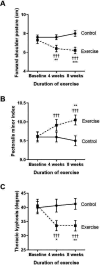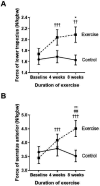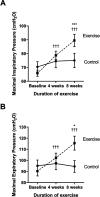Effects of scapulothoracic exercises on chest mobility, respiratory muscle strength, and pulmonary function in male COPD patients with forward shoulder posture: A randomized controlled trial
- PMID: 39281331
- PMCID: PMC11393525
- DOI: 10.12688/f1000research.126832.2
Effects of scapulothoracic exercises on chest mobility, respiratory muscle strength, and pulmonary function in male COPD patients with forward shoulder posture: A randomized controlled trial
Abstract
Background The postural abnormality, forward shoulder posture (FSP), is the most common cause of respiratory impairment in older individuals with chronic obstructive pulmonary disease (COPD). A recent study found that performing pectoral stretching and scapular strengthening exercises for eight weeks could reduce FSP in healthy participants. We aimed to determine the effects of pectoral stretching and scapular stabilizer strengthening exercises on FSP, chest wall mobility, respiratory muscle strength, and pulmonary function in male patients with COPD. Methods This study was randomized clinical trial. Forty male COPD patients with FSP aged 60-90 years were included and randomly allocated to control (n=20) and exercise (n=20) groups. Following completion of the scapulothoracic exercises (three days/week, for eight weeks), respiratory functions were assessed by measuring the magnitude of FSP, chest mobility, respiratory muscle strength, and pulmonary functions. Results FSP and thoracic kyphosis angle significantly decreased compared to controls (p<0.001, p<0.001). Middle and lower chest mobility markedly increased (p<0.001, p<0.001) and the pectoralis minor index significantly improved (p<0.001). The strength of the lower trapezius and serratus anterior muscles significantly increased at week eight of the exercise training (p<0.003, p<0.001). There was a marked increase in maximum inspiratory pressure and maximum expiratory pressure (p<0.001, p<0.001). Conclusions The eight-week combined pectoral muscles self-stretching and serratus anterior and lower trapezius strengthening exercises could be an effective treatment and/or prevention strategy for FSP reduction, leading to improved respiratory function in male COPD patients.
Keywords: COPD; scapulothoracic exercise; Respiratory muscles; Shoulders; Thoracic wall.
Copyright: © 2024 Thongchote K et al.
Conflict of interest statement
No competing interests were disclosed.
Figures




References
-
- Saenghirunvattana S, Kongngeon V, Aeimrerksiri B, et al. : Chronic obstructive pulmonary diseases in Thailand: incidence, prevalence, present status and future trends. J. Med. Assoc. Thail. 2001;84(10):11804249. - PubMed
-
- Kaneko H, Shiranita S, Horie J: Relationship between reduced thoracoabdominal wall mobility and respiratory function in patients with chronic obstructive pulmonary disease. J. Physiother. 2015;101:e716. 10.1016/j.physio.2015.03.3571 - DOI
Publication types
MeSH terms
Associated data
LinkOut - more resources
Full Text Sources
Medical

